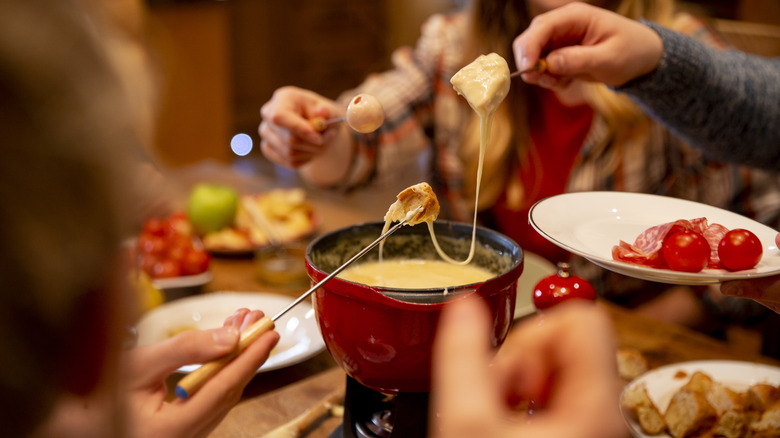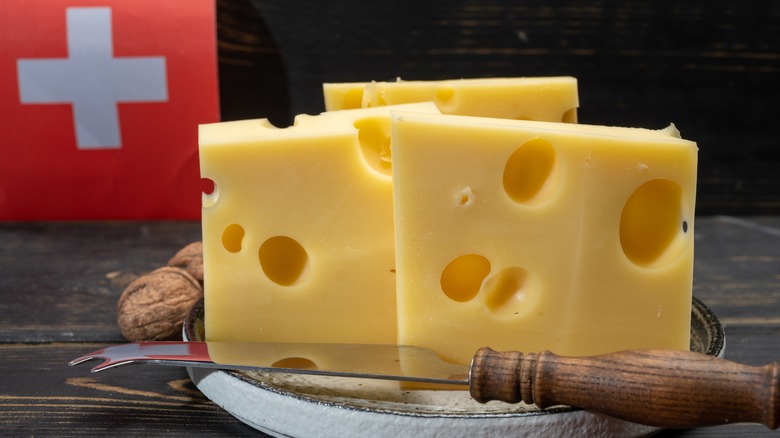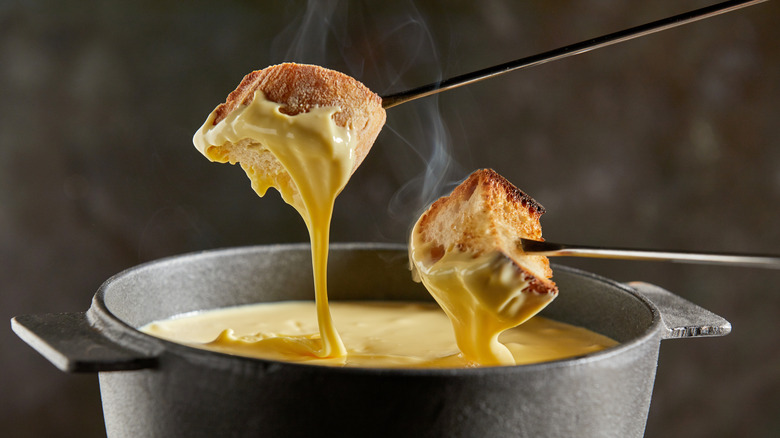Why Emmental Is The Ultimate Fondue Cheese
Emmental (also spelled Emmentaler, Emmenthaler, or Emmenthal) is one of the classic Swiss cheeses. This mild, semi-hard cheese dates back to 13th century Switzerland, and is named for the Emme river, in whose valley it was originally produced. These days, you're most likely to find Emmental in a traditional cheese fondue recipe.
While you can make a fondue with anything you like, running the gamut from a tangy beer and cheddar fondue all the way to a truly funky blue cheese fondue, Emmental is the default for a reason. This cheese melts well and has a flavor that is rich but not overpowering, making it a general crowd-pleaser that pairs well with a large variety of dippings. It's also one of the classic fondue cheeses, along with Gruyère (although Camembert makes a delicious fondue too). Though the dish has a storied history, the modern iteration of fondue has existed in Switzerland since around the late 19th century (depending on whom you ask). There must be a reason it's still around.
One of the quintessential Swiss cheeses
What we know in the U.S. as "Swiss cheese" is a broad category that can be applied to a variety of cheeses from Switzerland, but it is generally recognized as being interchangeable with Emmental, specifically. It is made from cow's milk and uses the "Swiss process," in which a special bacteria is allowed to feed on lactic acid, producing carbon dioxide bubbles. This is the reason Emmental and other Swiss cheeses have their signature holes, also known as 'eyes.'
Emmental comes from the same valley in Switzerland as Gruyère, another Swiss cow's milk cheese, and these two are often paired together. Both can be slightly nutty or fruity, but Emmental has a sweeter, more nuanced flavor while Gruyère is often richer and earthier. The reason that Emmental melts so well is because its slightly acidic pH allows the calcium in it to break down once heated, resulting in a cheese that stretches instead of clumps. Too much acid in the cheese, and the protein won't relax into a good melt. Too little, and there isn't enough acid to dissolve the calcium and allow for a decent stretch. Emmental is right in that sweet spot — balanced acidity.
How to enjoy Emmental in fondue
For fondue, you want to think of Emmental as the backbone of the operation. It won't be the loudest cheese in the mix — and that's fine — because it keeps the fondue creamy and plays well with others. You want to balance it out with some slightly stronger flavored cheeses, like Italian fontina and Dutch Gouda (and, of course, Swiss Gruyère).
Both melted and in fondue, Emmental pairs really well with crisp slices of Granny Smith apple or crisp pear, and some sliced salami. Of course, don't forget the bread! And since you're not supposed to drink water with fondue, but instead have white wine and kirsch (a cherry-flavored eau-de-vie), it is traditional to pair it with a glass of white wine, preferably something from Switzerland or nearby Alsace, like a Grüner Veltliner or riesling. Traditionalists will claim that this aids digestion, and whether or not that's true, it certainly tastes great alongside this subtle cheese.



